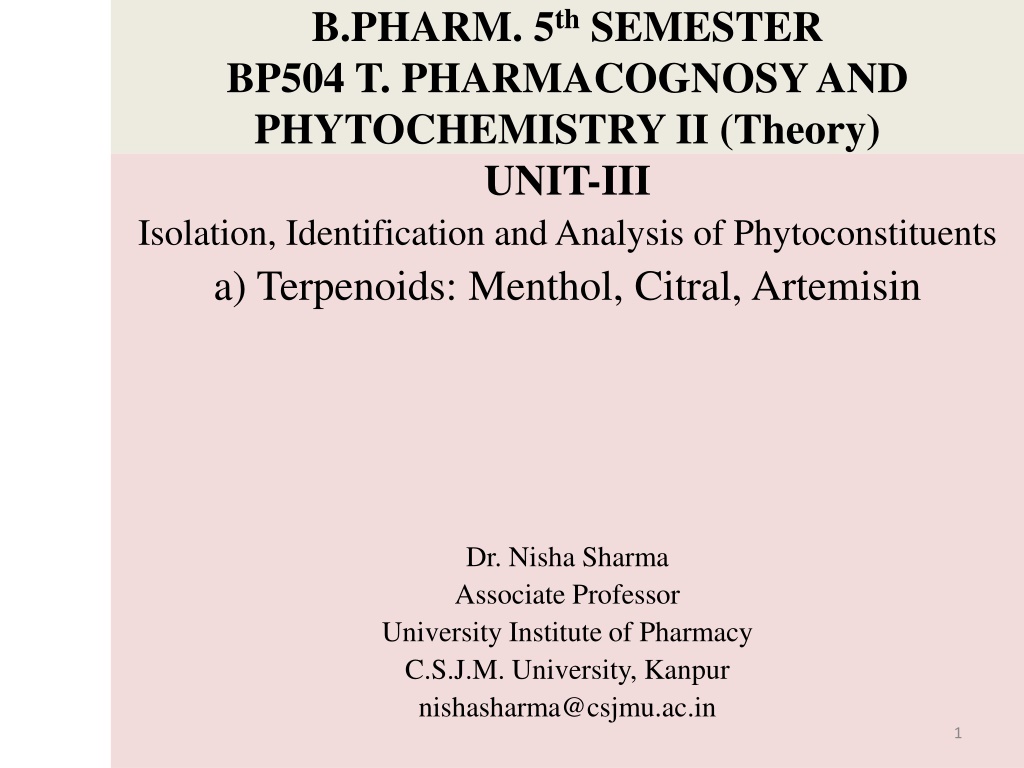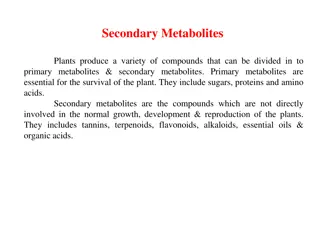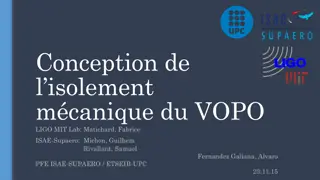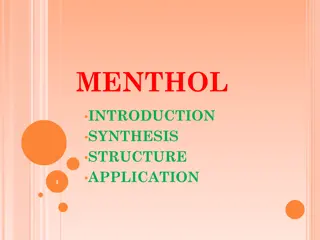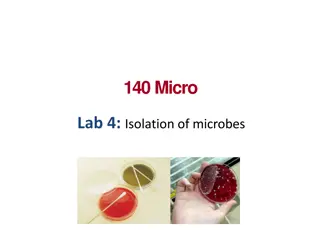Isolation and Analysis of Terpenoids: Menthol, Citral, Artemisin
Menthol, Citral, and Artemisin are important terpenoids commonly found in plants like Mentha species. The isolation methods involve hydro-distillation and steam distillation, resulting in the extraction of these valuable compounds for various pharmaceutical applications.
Download Presentation

Please find below an Image/Link to download the presentation.
The content on the website is provided AS IS for your information and personal use only. It may not be sold, licensed, or shared on other websites without obtaining consent from the author. Download presentation by click this link. If you encounter any issues during the download, it is possible that the publisher has removed the file from their server.
E N D
Presentation Transcript
B.PHARM. 5thSEMESTER BP504 T. PHARMACOGNOSY AND PHYTOCHEMISTRY II (Theory) UNIT-III Isolation, Identification and Analysis of Phytoconstituents a) Terpenoids: Menthol, Citral, Artemisin Dr. Nisha Sharma Associate Professor University Institute of Pharmacy C.S.J.M. University, Kanpur nishasharma@csjmu.ac.in 1
CH3 MENTHOL OH H3C CH3 2
Menthol Biological source: Menthol a monoterpene alcohol obtained from oils of Mentha piperita var. Vulgaris (Black peppermint) & Mentha piperita var. officinalis (White peppermint), family- Labiatate. Mentha species contains about 1-3% of volatile oils & oil contains not less than 44%. Isolation Menthol is isolated by 2 methods Method 1: Hydro-distilation Method 2: Steam distillation 3
Hydro-distilation Required quantity of coarse powder leaves of Mentha piperita. The peppermint oil is extracted by hydrodistillation method by using clevenger apparatus. The oil is separated from water and allow to cooling. After cooling crystals of (-) menthol will separate out. The crystals are collected by centrifugation and re- crystallized the menthol by acetone or any other low boiling point solvent 4
Hydro-distillation by Clevenger apparatus system 5
2. Steam distillation Required quantity of air dried mentha plant is charged into stainless steel still having perforated bottom. The steam under pressure is generated with the help boiler and steam is passed through the drug. The mixture vapour (water and volatile oil) are passed through the condenser where vapour is cooled and back to liquid form. The mentha oil is collected in separating can. Mentha oil is floated on top of the water due to lighter than water. The oil is then decanted and filtered. The oil is allowed to cool; crystal of menthol will separate out. 6
3. Method of Isolation Pippermint volatile oil- separated by steam & water distillation. To make oil free of moisture- it is passed through a bed of Na2SO4 The moisture free oil is frozen to -60 C for 7days by packing in tightly sealed plastic container. Menthol in oil separates as flaky crystals, separated by filtration. Mother liq. Containing some menthol along with other terpenes. The mother liq is treated with boric acid & further boiled for 3hr, followed by distillation for removal of menthone. Borate of menthol subjected to saponification with 50ml of NaOH by heating reflux for 1hr Resultant sol. Is allowed to cool for separation of remaining menthol crystals and mixed, dried in dessicator. 8
Properties: Appearance : White crystalline substances, which is solid at room temperature and melts slightly above (m.p. 41 to 43 C). Odor : Characteristic and pleasant Taste : Pungent followed by cooling sensation Solubility : Soluble in 70% alcohol, ether and chloroform, insoluble in water Identification by chemical test: Few drops of sample is mixed with 5ml of nitric acid and heated on water bath. Blue color is developed within 5 minutes, after some time it becomes yellow which indicate the presence of menthol. Small qty of menthol in TT + equal qty of thymol or camphor liquifaction of contents in TT presence of Menthol Crystals of Menthol in watch glass+ heat on water bath material evaporates 9
Analysis by TLC Sample preparation : 1mg of Menthol is dissolved 1ml of methanol Standard sample : Menthol Stationary phase : Silica gel 60 F 254 Mobile phase : Pure Chloroform , hexane:EtOAc::8:2 Detecting agent :1% vanillin sulphuric acid reagent and heat the plate at 110 C for 10 minutes Anisaldehyde sulphuric acid reagent, heat at 115 C 10min. RF Value : 0.34, 0.48-0.62 Utilization: It is used as in various dosage forms for its cooling sensation, flavoring property, carminative, antispasmodic and antipruritic Storage condition: It should be store in well closed and air-tight containers protected from light and in cool place. 10
Citral Cymbopogon flexuosus, C. citratus (Lemon grass), Lemon oil: Lemony, sweet smell, yellow in color 11
Citral Biological source: Citral is a monoterpene aldehyde obtained from oils of Cymbopogon flexuosus, C. martini belongs to family- Graminae. It contains not less than 75% of aldehyde calculated as Citral. It also present in Lemon oil (Citrus limonus) and Orange oil (Citrus aurantium), family Rutaceae. Isolation: Citral is isolated by following methods i.e. Method 1: Hydro-distilation Method 2: Fractional crystallization Method 12
Citral The fresh plant material is hydro- distilled to obtain lemon grass oil. It is purified by fractional crystallization. To the total oil, first Sodium sulphite is added, the citrals get converted into its sulphite salt. The salt crystallizes out of the solution. The crystals are filtered and washed with ether or chloroform. The product is then subjected to sodium carbonate treatment to recover Citral. Citral is found in two form i.e Citral-a (Geranial) and Citral-b (Neral). 13
Properties: Appearance : Clear pale yellow liquid Odor : Strong lemon like odour Taste : Lemon like taste Solubility : Soluble in 3 parts of 70% alcohol, chloroform and fixed oil. Insoluble in water. Boiling point : 224-228O C Identification by chemical test: Alcoholic solution of Sudan red III is added to the sample. Red colour is appeared which indicate presence of citral. Tincture alkane is added to the sample. Red colour is appeared which indicate presence of citral. 14
Analysis by TLC Sample preparation : 1mg of Citral is dissolved 1ml of methanol Standard sample : Citral Stationary phase : Silica gel G Mobile phase : Pure Chloroform Detecting agent : 2, 4, dinitrophenyl hydrazine reagent Color spots : Yellow to orange RF Value : 0.51 Utilization: It is used as a flavouring agent and perfumery. Commercially citral is act as precursor for the synthesis of -ionone. -ionone is used as starting material for the synthesis of Vitamin A Storage condition: It should be store in well closed and air-tight containers protected from light and in cool place. 15
Artemisin Artemisia cina (Santonica) 16
Artemisin Biological source Artemisin is a sesquiterpenoid lactone, obtained from the unexpanded flower- heads of Artemisia cina Berg, Artemisia brevifolia Wall, Artemisia maritime Linn. and other species belongs to family Asteraceae. It contains 2-3% of essential oil and two crystalline substances i. e Santonin and Artemisin. 17
Isolation: The air dried powdered of herb is macerated in methanol for 1 hour with magnetic stirrer having speed of 700 rpm. This process is repeated until methanol layer become colorless. The extract is evaporated by rota-evaporator at a temperature of 40 C until volume is reduced to 100ml. The methanolic extract is partitioned using 50ml hexane (Hexane: Methanol, 1:2) until colorless hexane layer is obtained. Hexane and methanol extract is separated by using separating funnel. 10ml of distilled water is added to methanolic extract and partitioned by 50ml of ethyl acetate until ethyl acetate layer become colorless. Again ethyl acetate and methanolic extract is separated. Both extracts are concentrated by using rota evaporater at a temperature of 40 C. Artemisin is fractionated by column chromatography using silica gel 60 as stationary phase and ethyl acetate: hexane as mobile phase 18
Identification by chemical test: Sample is boiled with 10ml of alcohol and filtered. Sodium hydroxide is added to filtrate and heated. Red colour is appeared in liquid . Analysis by TLC Sample preparation : 1mg of Artemisin is dissolved Chloroform Standard sample : Artemisin Stationary phase : Silica gel G Mobile phase : Petroleum ether - Ethyl acetate (1:2) Detecting agent : p- dimethyl amino benzaldehyde and heat at 80 C to produce color RF Value : Compare with standard Artemisin 19
Artemisnin Analysis by UV 1mg of Artemisin is mixed with 10ml of methanol and analysed 200-400nm. Utilization: It is used as antimalarial. It acts both against chloroquine sensitive and resistant P. falciperum and P. vivax malarial parasites. Storage condition: It should be store in well closed and air-tight containers protected from light and in cool place. 20
References Lecture notes by Mr. Ashutosh Meher, Associate professor, Barpali, Bargarh, Odisha 21
